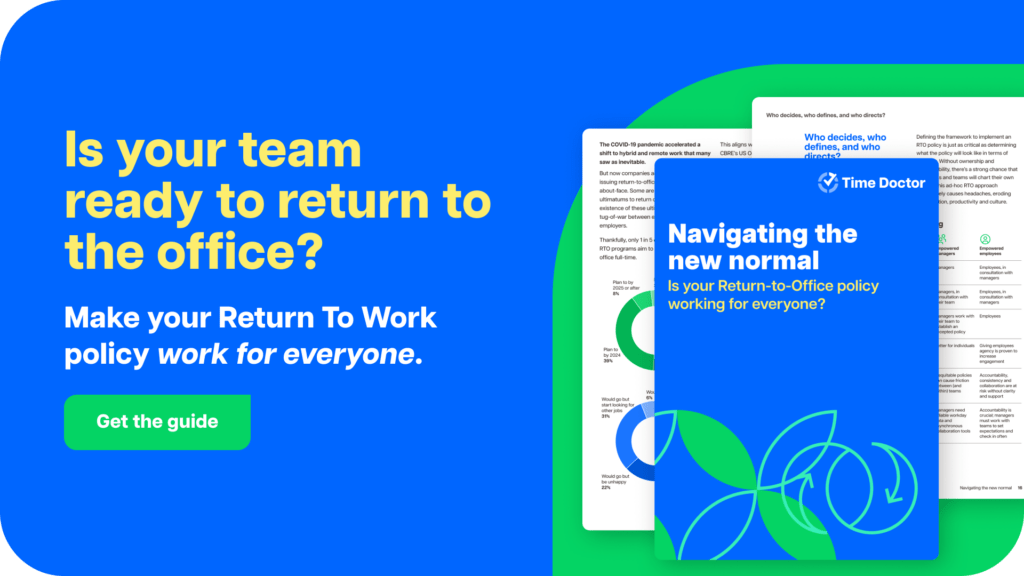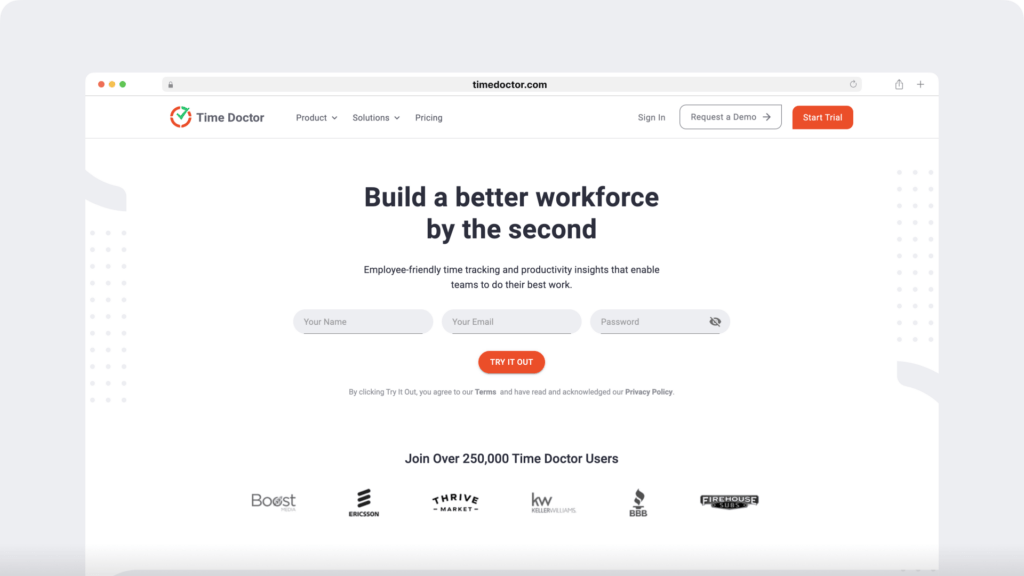Your guide to data-driven remote workforce management in the “new normal”
Hybrid work schedules have been a hot topic for most of this year, and we don’t imagine that will change in 2024. On the contrary, the hype around hybrid work is likely only just beginning.
As champions of work-from-anywhere culture, the entire Time Doctor team is firmly seated on the bandwagon. We’re cheering on the companies leaning into hybrid and remote workforce management and helping them by removing barriers.
However, not everyone is as excited. As the dust settles on a tumultuous few years, many companies are pulling back on the reins. They are issuing “return-to-office” (RTO or return-to-work) policies to recall teams back to HQ.
RTO policies are tricky. Although useful for some teams and essential for some roles, a poorly communicated policy – or one that falls short of employees’ expectations – can do more harm than good.
The crucial ingredient that decides whether an RTO policy succeeds or falters is productivity analytics. Simply put, if you don’t know how to measure employee productivity, there’s little chance of cultivating a productivity culture or making decisions based on more than a hunch.
More than any other factor, reliable workday data is important because it:
- Builds a business case for hybrid schedules
- Reveals insights about where and how people work
- Reinforces the mutual value of a productivity culture
- Creates accountability and gives employees agency
- Gives managers and leaders peace of mind
Productivity analytics also helps to benchmark performance, boost employee engagement and build clients’ trust. You can see how it works in practice by scheduling a 1:1 demonstration with a Time Doctor productivity specialist.
But all of that is still to come. First, let’s look at the role of productivity analytics in designing, communicating and optimizing a hybrid RTO policy.

Employees don’t think the Great Office Return is so great
Before the pandemic in 2020, many big cities were running out of office space. Three years on, half the seats stay empty more than half the time. European office occupancy rates were 15% below 2020 levels at 55% in early 2023, and the average across 10 major US cities was exactly 50% as of late October.
In both cases, Tuesday is the busiest day while Friday remains unilaterally unpopular. Wednesday and Thursday are Europe’s second and third favorite office days.
Now that in-person restrictions have been lifted in the US, Europe and most other countries, people are free to work in the office as often as they want.
The only problem? They don’t want to. At least, not full-time.
OwlLabs’ latest State of Hybrid Work survey found nearly two in three US workers (59%) would be unhappy about a forced five-day-per-week RTO policy. One in three (31%) said they would immediately start looking for another job, and 6% would quit.
What these figures highlight – and they echo countless surveys, studies and think pieces from the last few years – is not a rejection of return-to-office policies but a desire for flexibility and autonomy.
Forcing employees who can work remotely to spend five days in the office is bad for culture and productivity. Transitioning to 100% remote work is better, but still not most people’s preference.
The ‘Goldilocks zone’ seems to be a 50/50 split between in-office and remote working.
Let’s review what we know so far
- Most employees don’t want to return to five-day office weeks
- Thousands of survey respondents tell us that 2.2 to 3 days per week is the sweet spot for in-office work
- People seem to prefer working in the office on Tuesdays and Wednesdays instead of Mondays and Fridays
Based on these three insights, you might be starting to see how RTO policies and hybrid work schedules are the same. This is likely the insight that led Google to announce A hybrid approach to work and Citi Group to brand their three-day-per-week RTO policy as a hybrid work model.
Although it might seem like splitting hairs, these companies choose “hybrid” over “RTO” because they know what employees want. It’s a decision based on data, insight and feedback.
Positioning plays an important role in implementing a policy that works for everyone.
The question remains, though: does it work for your organization?

Building the case for a hybrid work schedule
We might be champions of remote and asynchronous work, but we’re also realistic. Hybrid work schedules are effective for most modern teams, at least in the current climate.
Whether 50/50 is the first step towards 100% remote workforce management or the final balance depends on an incredibly nuanced evaluation of culture, employee preferences, remote readiness and productivity potential.
Clarify the purpose
The first step is building a business case for RTO or hybrid work schedules based on organizational goals. This is an unskippable step: employees worldwide feel increasingly disconnected from their company’s purpose, and a “because we said so” return-to-office policy is likely to be the point where people walk away.
- Work with leaders to define how hybrid work or RTO is imperative in achieving organizational goals
- Stress-test RTO outcomes using productivity data to see whether hybrid or remote working can achieve the same objectives
- Identify gaps, weaknesses and opportunities in current practices, tech and communication
Returning to the office should only ever be a strategic initiative. If you can prove with data that remote workforce management or hybrid work schedules achieve better results, now is the time to advocate for leaning into hybrid work.
Survey employees, managers and leaders
Much of the tension that plagued RTO policies in 2023 (and is likely to continue next year) arose from a mismatch between employers’ and employees’ preferences. To understand the internal context that could lead to conflict, gather data on:
- Individual work preferences (remote, in-office, or hybrid)
- Productivity and job satisfaction
- The challenges employees face in different environments
- Communication and collaboration preferences
- The perceived impact on work-life balance and mental well-being
The goal is to identify and analyze the spectrum of preferences, expectations and concerns regarding hybrid work schedules. To read the room, in other words.
This survey data helps to frame a hybrid work policy and becomes valuable when checking in down the track.
Use workday data to measure employee productivity
Surveys help to set the frame, but it will likely throw up questions that can only be answered with productivity analytics.
For example, line managers might tell you their preference is for full-time office work – but is that really where people are most productive? By collecting and analyzing workday data from across the organization, you can start to:
- Build a case for policy decisions
- Shape the hybrid work schedule to match when people are most productive
- Identify coaching needs and process weaknesses
- Encourage accountability among people trusted to work remotely
- Prove to clients and partners that distributed work is working
- Optimize working schedules to reduce overheads
- Plan workspace requirements
Productivity analytics provides insights that turn one-dimensional survey responses into actionable strategies. It also helps to understand the nuances of productivity in a way that in-person observation is often blind to.
Most importantly, though, productivity data gives managers and employees peace of mind.
What happens when RTO policies exist in a data vacuum
At the beginning of the pandemic, most of the world transitioned to working from home with no real guidelines or guardrails for remote workforce management. We figured it out as we went – to varying degrees of success.
Although we hoped to have learnt something, it seems many leaders are repeating the same chaotic mistakes.
A recent survey of over 1,100 senior execs in the US found that 80% “would have approached their company’s return-to-office strategy differently if they had access to workplace data to inform their decision-making”.
The problem is twofold:
- Productivity data was fragmented and time-consuming to gather
- Gaps and cumbersome processes meant a lot of guesswork was involved
It’s not a lack of data that leads to short-sighted RTO policies; 96% of respondents reported having access to it. It’s the fact that 64% needed to pull data from multiple sources, 48% had to contact external vendors, and 45% relied on manual spreadsheets.
No wonder nearly one-quarter (23%) admitted to making return-to-office decisions based on gut instinct. And no wonder 80% would have done things differently.
On the other side of the coin, we have Executive Mosaic, a proud Time Doctor customer, media agency and remote workforce management advocate. In a “stroke of unintentional genius”, Executive Mosaic’s team transitioned to remote working right before the pandemic hit.
Time Doctor was the key deciding factor. The leadership team gained peace of mind that enabled them to trust employees, and in return, employees saved hours every day by avoiding rough commutes.
When the dust settled, Executive Mosaic asked nearly 100 staff whether they wanted to return to the office. A whopping 0% said yes.
What data do we need?
| What you need to know | Which metrics to track | Why it’s useful |
| Comparisons of remote vs in-office productivity | – Productivity trends – Office attendance – Breaks, distractions and unproductive time – Website and app usage | Every strategy needs a starting point, and regular check-ins help to understand whether the policy is working |
| Individual and team benchmarks | – Productive vs non-productive time – Project and task completion – Client satisfaction scores | Hybrid work schedules give employees the flexibility they want, and self-management tools like Time Doctor make them accountable for their time |
| Employee engagement metrics | – Productivity data – Absenteeism – Turnover – Customer satisfaction – Financial results | Measuring engagement over time tells you how people are responding to the RTO policy, even if they’re not willing to speak up |
| Work-life balance data | – Overtime hours – Weekend work – Long days – Absenteeism and unscheduled breaks | Declining work-life balance is a demonstrated downside of forced RTO, and a big reason employees don’t want to come back full-time |
Next steps: What else you need to design a hybrid work schedule that works for everyone
Research industry trends
Assessing what others in your industry are doing provides a broader perspective on how best to adapt to the modern work environment. Desktop research of competitors and companies you admire is usually sufficient to understand the highlights, like how they’re positioning the RTO policy and what tech they’re using to transition.
Just remember that examples are useful only for guiding high-level policy discussions. Differences in culture, workforce composition, customer expectations and market make it impossible to copy an RTO policy with any success.
Involve representatives from all levels
An RTO policy (slash hybrid work schedule) that works for everyone is built by everyone. Select representatives from each major working group to contribute to the policy to prevent a top-heavy design process.
How this works in practice depends on the organizational goals in focus, as well as the myriad requirements, limitations and capabilities unique to the organization.
In other words, it can be complicated.
To help you transition to hybrid work seamlessly, we’ve developed a step-by-step guide to designing an RTO policy that works for everyone. The guide includes actionable insights and practical frameworks to guide decision-making at every stage.
Download it for free here when you’re ready to co-create a hybrid work schedule.
Communicate clearly, consistently and concisely
In a 2023 survey, Asana’s Work Innovation Lab learned that 24% of employees didn’t know who created their organization’s hybrid policy. Almost half (43%) couldn’t find the policy on the company’s intranet, and 19% couldn’t find it at all.
This aligns with McKinsey data from 2021 that showed 40% of organizations hadn’t communicated a post-pandemic plan at all and 28% only vaguely.
In our latest article about RTO in the media, we look into why companies like Apple, Zoom and Amazon copped backlash after announcing hybrid policies.
As a teaser, their fault was a failure to communicate the purpose, plan and impact, and involve employees in decision-making.
Measure success – and be open to suggestion
RTO policies are hard to get right the first time. But with good data, people-first management and clear communication, the policy can adapt and improve.
It’s no surprise that roughly the same proportion of companies are leaning into hybrid work and using productivity analytics tools. Hybrid work schedules can’t be successful without close oversight and transparent data.
| 50-75% | 60-78% |
| of companies are leaning into hybrid work. | of companies use productivity analytics tools. |
| Coincidence? It can’t be. |
Productivity analytics isn’t just helpful for keeping an eye on performance. It’s essential for bridging the chasm between employee and employer expectations and preventing miscommunication in remote work environments.
More than anything, reliable productivity analytics provides a clear answer to the inevitable criticism that comes from both sides with RTO policies.
Turn RTO policy pains into hybrid work success stories

Returning to the office after years of working remotely or flexibly is a shock. Organizations that rush the transition, impose harsh penalties on non-attendance, or fail to read the temperature of the room will see some of their best people walk.
While surveys and managers’ experience offer guidance to overcome return-to-office resistance, productivity analytics provides the business case, evidence and progress data.
Bottom line? If you want to know your hybrid work policy is working, you need to know how, where and when people are working.
Implementing Time Doctor gives everyone in your team access to the insights that make hybrid work schedules successful. Our employee-friendly features and transparent data dashboards provide peace of mind, encourage a healthy productivity culture and make people accountable for their time.
Book a consultation with our expert team to see how Time Doctor can streamline your company’s transition to a hybrid work schedule.
Book a demo today!

Carlo Borja is the Content Marketing Manager of Time Doctor, a workforce analytics software for distributed teams. He is a remote work advocate, a father and a coffee junkie.


